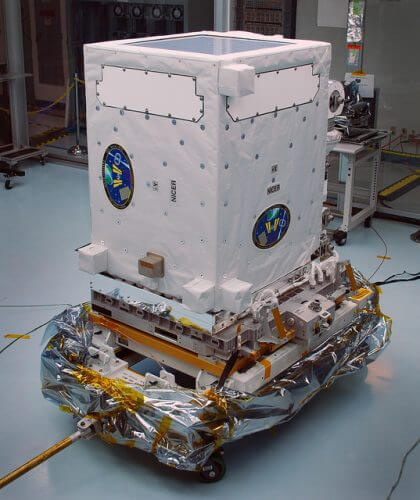Neutron Star Interior Composition Explorer, or NICER for short, is the name of a telescope in the field of X-rays that was launched in early June aboard SpaceX's Falcon 9 launcher and is currently installed on the International Space Station, by mid-July it should begin its scientific work - to study exotic astrophysical objects known as neutron stars and to test whether they can be used as deep space navigation beacons for future generations of spacecraft
Author: Prof. Wynn Ho University of Southampton
Translation: Avi Blizovsky

Neutron Star Interior Composition Explorer, or NICER for short, is the name of a telescope in the field of X-rays that was launched in early June aboard SpaceX's Falcon 9 launcher and is currently installed on the International Space Station, by mid-July it should begin its scientific work - to study exotic astrophysical objects known as neutron stars and to test whether they can be used as deep space navigation beacons for future generations of spacecraft.
What are neutron stars? When stars at least eight times as massive as our Sun exhaust all their hydrogen fuel, through thermonuclear fusion reactions, the pressure of gravity causes them to collapse. A supernova explosion occurs, causing most of the star's material to be thrown into space. What remains will become a neutron star or even a black hole.
I study neutron stars because of the rich variety of astrophysical phenomena and the many fields of physics to which they are connected. What makes neutron stars most interesting is that the mass of such a star is 1.5 times the mass of the Sun but its diameter is only 25 km, the size of a city. When you compress this large mass into such a small volume, the body becomes denser than a nucleus of an atom. So, for example, while the nucleus of a helium atom has only two neutrons and two protons, a neutron star is actually a single nucleus consisting of 10 to the 57 neutrons and 10 to the 56 protons.
We can use neutron stars to study properties of nuclear physics that cannot be studied in laboratories on Earth. For example, some current theories predict that exotic particles of matter, such as hypons and decaying quarks, can appear in the high densities present in neutron stars. Theories also show that at temperatures of a billion degrees Celsius, protons in the neutron star become superconductors and neutrons, which lack the electric charge, become superfluids.
The magnetic fields of neutron stars are also extreme, perhaps the strongest in the universe, and several billion times stronger than anything created in laboratories. While the gravity on the surface of a neutron star may not be as strong as that near a black hole, neutron stars still create large distortions in space-time and can be sources of gravitational waves, theorized in neutron star research in the XNUMXs, and confirmed in recent years by experiments of the LIGO project.
NICER's primary mission is to precisely measure the mass and radius of individual neutron stars—and although the telescope will also study other types of astronomical objects, those of us who study neutron stars hope that NICER will provide us with unique insights into these fascinating objects and their physics. NICER will measure how the brightness of a neutron star changes with its energy, and how it changes as the star rotates and reveals different parts of its surface. These observations will be compared to theoretical models based on the star's properties, such as mass and radius. Accurate determinations of mass and radius will provide an essential test of the nuclear theory.
Another aspect of neutron stars that could be important to future space navigators is their rotation - which will also be tested by NICER. Spinning neutron stars, known as pulsars, emit radiation like a beacon and appear to spin at 716 times per second. This rotation rate in some neutron stars is more stable than the best atomic clock we have on Earth. In fact, it is this characteristic of neutron stars that led to the discovery of the first planets outside our solar system in 1992 – three Earth-sized planets orbiting a neutron star.
The NICER mission, using a part of the telescope called SEXTANT, will test whether the remarkable regularity and stability of a neutron star's rotation can be used as a system of navigational beacons in deep space. Neutron stars can serve as natural satellites that contribute to a galactic positioning system and can be relied upon to navigate manned and unmanned interstellar (outside the solar system) spacecraft.
The NICER telescope will operate for 18 months, but it is hoped that NASA will continue to fund its operation even after that, especially if it can satisfy the ambitious scientific goals it has set. I also hope that NICER will combine and greatly enhance the invaluable capabilities of previous X-ray spacecraft - RXTE, Chandra and XMM-Newton - used to reveal the mysteries of neutron stars and properties of fundamental physics. The first neutron star, a pulsar, was discovered in 1967 by Jocelyn Bell Bernal. It would be appropriate to achieve breakthroughs about neutron stars in the anniversary year of its discovery.
To the original article, under the CC license

4 תגובות
If a neutron star consisted only of neutrons and protons, then it would have a huge positive charge - and to my understanding, this is not the case.
What are Nippons and quarks decaying
What is not clear to me - will the vibrations and movements in the space station (people walking around there) affect the resolution of the direction from which the X-ray signal comes? Or maybe this telescope has a low resolution?
And a note of accuracy: Neutron stars do not spin at 716 revolutions per second, at least not all of them. It can be written that the fastest rotates at this speed.
Falcon 9 launcher (because of the nine rocket engines in the first stage) of SpaceX
And really not as written.